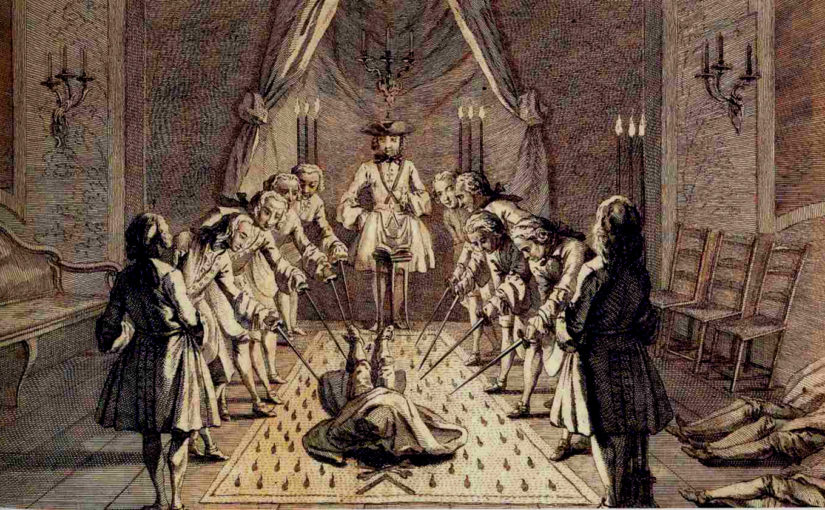WHO SLIPPED WHAT IN THE MASONIC 3RD DEGREE
The purpose of this paper is to expand some thoughts on the ceremony of Raising and its history in Freemasonry. The story of the Third Degree presents several problems. If we consider the basic premise that just before the completion of King Solomon’s Temple in the 2896 Anno Lucis or 975 BCE [1] (these dates vary in different editions) , there was a conspiracy of 15 Fellowcraft to obtain the secrets of the Third Degree.
- What could the Third Degree then have included?
- What were those secrets?
It could not have been a Raising since Hiram Abiff was still alive. The only Third Degree we know came as a result of his death. Presumably Fellowcraft would only have been appointed if they were honourable men, whether they were actual masons or free and speculative ones. How would one find so many (admittedly 12 recanted and only three conspirators remained) who were prepared to resort to violence and even commit murder of someone for whom they would surely have had respect, simply to obtain some secrets? These they were going to learn anyway in due course, so that the story creates a lack of credibility.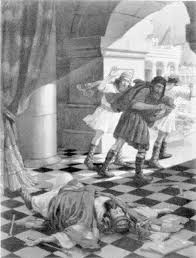
Having killed their master, the candidate of the degree is made to represent him and is symbolically raised from death by various artifices (i.e. the five points of fellowship etc). He is then told the remainder of the story known generally as the “Traditional History”. In this, King Solomon sends 15 trusty Fellowcraft (9 in early French rituals) to search for Hiram Abiff, assuming he may have been killed in an attempt to extort from him the secrets of the Third Degree. This is surely putting subsequent knowledge retrospectively in the minds of the protagonists involved.
Three lodges of five Fellowcraft were sent to search. The second group finds Hiram Abiff indecently buried, reports this to King Solomon who orders him to be exhumed and reburied as near the Holy of Holiest as Israelite law would allow. (This has no parallel in the Bible or the Talmud[2]). Meanwhile, the signs of the Third Degree become the anguished gestures of the second group of Fellowcraft and are ordained to remain until the original signs (whatever they were meant to be) are restored!
The three Fellowcraft conspirators responsible for the crime are found by the third group of Fellowcraft, in a cave near Joppa [the ancient city of Jaffa, now the oldest part of Tel Aviv].
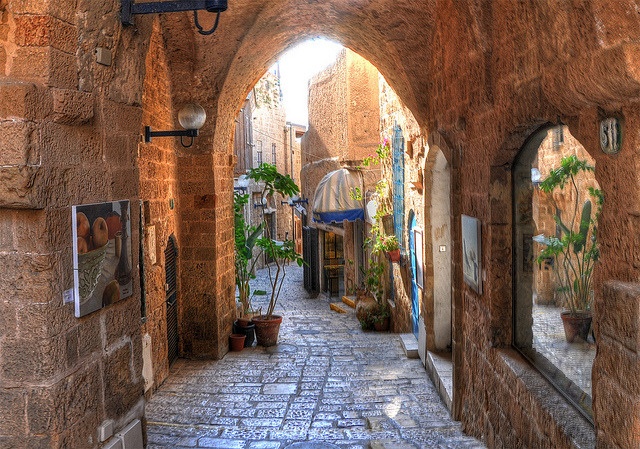
They admit to the murder and are taken to Jerusalem where King Solomon sentences them to death. A description of the tools of the degree and the Tracing Board are then explained, containing many peculiar items. In early versions of the Third Degree the three murderers were heard in the cavern, to refer to the penalties of the Third Degree – creating a possible problem since they would not yet have known them. But earlier versions of the First and Second Degrees appear to have incorporated all the penalties, which might explain the position.
Our Master Hiram Abiff
Now let us deal with the main character in the Third Degree – our Master, Hiram Abiff, who is mentioned in the Bible in both the Book of Kings I and Chronicles. Is it Hiram Abiff or Hiram Aviv or Huram Aviv?
In 1 Kings Chapter 7 Verse 13 [of the Bible] , Solomon sent and fetched Hiram out of Tyre. He was the son of a worker in brass (Choreish Nechoshet) but he was himself “cunning to work all works in brass”, wise and skilful indeed, but only brass is mentioned.
In 2 Chronicles 2 : 7, Solomon asked Hiram King of Tyre “for a man cunning to work in gold, silver, brass, iron, purple, crimson and blue and in engraving” (note this is not in the Book of Kings). Verses 13 and 14 contain the King of Tyre’s reply. Verse 13 “and now I have sent a cunning man endued with understanding, Huram my father” (Le Huram Avi). Verse 14 “skilful to work in gold and in silver in brass in iron in stone and in timber, in purple in blue and in fine linen and in crimson; also to grave any manner of engraving”
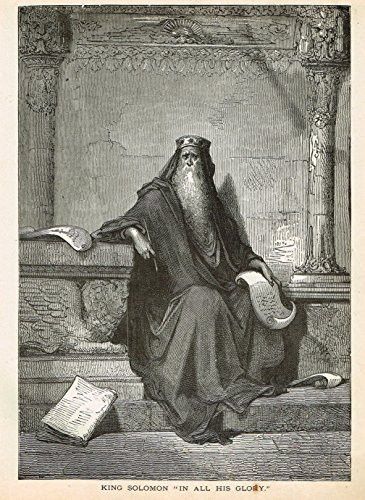 There is a notable increase in the range of skills attributed to Hiram Abiff. The reference to stone and timber implies that he was a mason and a builder. “Huram my father” indicates that Hiram, the craftsman, was highly esteemed by Hiram King of Tyre. The Hebrew word “av”, which literally means father, is frequently used in the Bible in the sense of “teacher, counselor, master or master craftsman” as a mark of great esteem. E.g. in Genesis XIV 8 Joseph says “God has made me a father to Pharaoh.”
There is a notable increase in the range of skills attributed to Hiram Abiff. The reference to stone and timber implies that he was a mason and a builder. “Huram my father” indicates that Hiram, the craftsman, was highly esteemed by Hiram King of Tyre. The Hebrew word “av”, which literally means father, is frequently used in the Bible in the sense of “teacher, counselor, master or master craftsman” as a mark of great esteem. E.g. in Genesis XIV 8 Joseph says “God has made me a father to Pharaoh.”
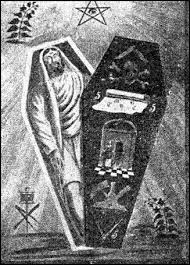
Later in 2 Chronicles 4 : 16, in a catalogue of Temple utensils and implements made by Hiram Abiff, we find the original Hebrew words “Huram Aviv”, which are transliterated to form the name we use in our ritual. 2 Chronicles 4 : 16, “and all their instruments did Huram/Hiram his father (Hiram Aviv becoming Hiram Abiff) make to King Solomon, for the House of the Lord.” In Robert Barker’s Bible of 1616 it says, “Whom Solomon reverenced as a father” or “reverenced as if he were Solomon’s father”, i.e. David, who designed, according to the Book of Chronicles, many of the instruments and implements used in the Temple.
“It is not surprising,” said Harry Carr, “that the Hebrew words Avi (my father) and Aviv (his father), posed difficulties for the early translators”. Luther in his translation of 1533, gave the name as Huram Abiff in both cases, whereas only in II Chronicles IV 16, does the original Hebrew justify the words “Hiram Abiff.”
Incidentally, neither of the two versions of the building of King Solomon’s Temple describes Hiram Abiff as an architect (let alone the principal architect), nor is there any mention at all of his death. The legend of Hiram Abiff is, therefore, pure legend.
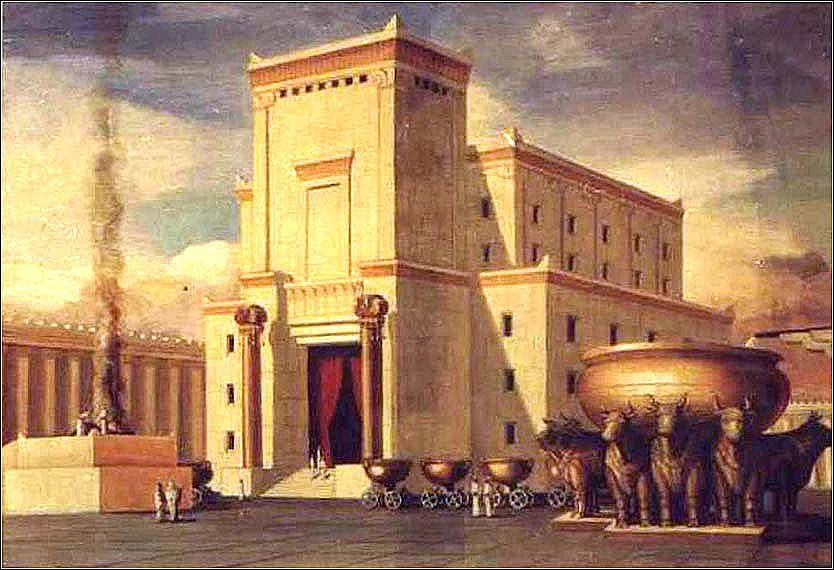
In the old charges (14th-17th Centuries) there was someone called “Aymon” (possibly a corruption of Amnon, one of David’s sons). Amnon means faithful one or steadfast. “Amon” is a master workman in the revised version of the Bible, while Amman (song of Solomon 7, 1-2) is translated as a cunning workman in the Authorised and Revised versions. Some further translations are Artificer, Architect or Artist.
The Charlemagne Ballad Cycle (14th Century) has the story of the four sons of Aymon, one of the first works printed in England by Caxton in 1485. In that story, Renaud, the eldest son, is stated to have worked as an operative mason at the building of Cologne Cathedral, when he was slain with a mason’s hammer or maul, by some of his fellow masons who were jealous of his superior strength.
An early version of the Hiramic legend has the word “mach”, which is an acrostic for the Hebrew letters mem aleph chet, which stands for the words matzanu avinu hiram, meaning we have found our master, Hiram.
The theory that there were two Hirams, father and son, was developed and supported by W.Bro. Rev. Morris Rosenbaum and Prof. Marks in a paper on “Hiram Abiff.” [3] It was their opinion that while the majority of readers find no visible reference in the Bible to the death of Hiram Abiff some indirect reference to his disappearance does exist in the Holy Scriptures. This they attempt to demonstrate on the assumption that there were two Hirams, father and son; one descended from the Tribe of Dan, while the other was from Naphtali. They attempted to explain the apparently varying accounts of antecedents in Kings and Chronicles. The father, a brass smith only, made the pots and other Temple utensils, while the son, an all-round craftsman, made the two pillars. It was the latter who was the widow’s son of the Tribe of Naphtali, having become a widow’s son, in fact, by the death of the father. However, it is the father whose death we commemorate. On this basis, they say, Hiram Abiff literally translated as Hiram, his father, must have died while the Temple was being erected. This explains the statement that “King Solomon sent and fetched him (the son) out of Tyre” ostensibly to complete the work his father’s death had left unfinished.
This theory of two separate and distinct but related Hirams is credited by the Rev. Dr. A. Cohen P.M., to a still earlier non-Masonic writer, the Jewish commentator, Meir Loeb Malbin (1809). However, the anomaly in a father and son both having the same name creates a real problem. This never happened before the exile and is rare today except in Sephardic[4] circles. The Hebrew text in Chronicles gives the name Huram and Hiram in the same verse, thus indicating that two different craftsmen are here meant. However, in the parallel passage in Kings, Hiram is given in both instances. The difference between the two names could be due to a printing error.
No satisfactory explanation has so far been offered for the circumstance of Hiram Abiff’s death not being clearly alluded to in the Bible. The attempt of Rosenbaum and Marks to ascribe this to the fact that it was a “Masonic Secret” is unacceptable, when it is clear that the non-historical theory of the origin of our institution from the building of King Solomon’s Temple, has been pretty well demolished. There is a Jewish legend to the effect that in reward for his participation in the erection of the Temple, Hiram never experienced death but was taken up alive into Heaven.
This legend may be the origin of our tradition. However, death even violent and treacherous, was a common experience in those barbarous times, as in our own. The omission of a clear report of Hiram Abiff’s death in Kings, Chronicles,Ezekiel, Jeremiah or even Josephus, not to mention the legends of the rabbis, makes the story of the two Hirams totally suspect and unacceptable.
The Christological influence on the Third Degree is considerable. Numbers always had magical or mystical significance in ancient religions and although Judaism does hold the number three as significant, it does not equal in any way the importance of the number in Christianity and the Third Degree (see end notes).
The story of the Degree itself called “Death, Decay and Resurrection”
- It proves a slip
- It proves a slip likewise
- A rather gruesome tale
These words are the relic of something that was a distinct feature of all early versions of the Third Degree. If one were challenged today to describe the lessons of the Third Degree, most Brethren would say “Death and Resurrection” and they would be right; but originally there were three themes not two, and all our early versions of the Third Degree confirm three themes: Death, Decay and Resurrection.
Any brother who has a compost heap in his garden would see the significance of this “Life Cycle”. Eventually, the decay theme was polished out of our English ritual, but “the slip”, which is directly related to that theme, remains as a reminder of the degree in its very early days. The first appearance of “the slip” in a Masonic context, was in Samuel Prichard’s Masonry Dissected of 1730. That was the first exposure claiming to describe a system of three degrees and it contained the earliest known version of the Hiramic Legend. It was framed entirely in the form of Question and Answer, and the main body of his version of the legend appears in reply to only two questions.
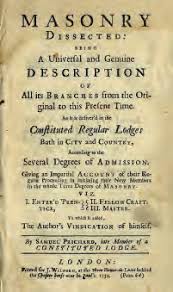 Many other and better versions have appeared since 1730, but Masonry Dissected (though it gives no hint of a long time lag which might have caused decay) was the first to mention “the slip” and to indicate that the cause was decay. The words occur in a footnote to the so-called “five points of fellowship”.
Many other and better versions have appeared since 1730, but Masonry Dissected (though it gives no hint of a long time lag which might have caused decay) was the first to mention “the slip” and to indicate that the cause was decay. The words occur in a footnote to the so-called “five points of fellowship”.
When Hiram was taken up they took him by the forefingers and the skin came off which is called the slip.
The next oldest version of the Third Degree was published in Le Catechisme de Francs-Macons in 1744, by a celebrated French journalist, Louis Travenol. It was much more detailed than Prichard’s piece and full of interesting items that had never been seen before. In fact, it was acted out as a drama in historical costume. In the course of this story, we learn that nine days had passed since the death, when Solomon ordered a search for the body of Hiram Abiff, which also occupied “considerable time”. Then following the discovery of the corpse of Hiram Abiff:
One of them took hold of it by one finger and the finger came away in his hand; he took him by another finger with the same result and when taking him by the wrist it came away from his arm. He called out “Macbenac” which signifies among the Freemasons the flesh falls from the bones.
In 1745, Travenol’s version was pirated in L’ordre des Francs-Macons Trahi, but there were a few improvements:
The flesh falls from the bones or the corpse is decayed
The English exposure Three Distinct Knocks of 1760 used the words “almost rotten to the bone”. Before the end of the 18th Century the decay seems to have gone out of use in England, so that “the slip” in word and action remains as the last hint of the story as it ran in its original form. The decay theme is not completely lost. Several ritual workings in French, German and other jurisdictions, still retain it as part of their version of the Hiramic Legend.
One more document needs to be quoted because it has particularly important implications. The Graham Manuscript of 1726 is a unique version of the Catechism plus religious interpretation, followed by a collection of legends relating to various Biblical characters in which each story has a kind of Masonic twist. One of the legends tells how three sons went to their father’s grave:
For to try if they could find anything about him for to lead them to the vertuable secret which this famous preacher had. Now these three men had already agreed that if they did not find the very thing itself, that the first thing that they found was to be to them as a secret ……. . so came to the grave finding nothing save the dead body almost consumed away. Taking a grip at a finger it came away so from joint to joint so to the wrist so to the elbow so they reared up the dead body and supported it setting foot to foot, knee to knee, breast to breast, cheek to cheek and hand to back and cried out “Help O father” so one said “Here is yet marrow in this bone”. The second said “But a dry bone”. And the third said, “It stinketh”. So they agree for to give it a name as is known to Freemasonry to this day.
The decay theme again, but in this version the famous preacher in the grave was not Hiram Abiff, but Noah and the three sons were Shem, Ham and Japheth. The appearance of this legend in 1726 – four years before the earliest Hiram Abiff version by Prichard – implies without doubt that the Hiramic Legend did not come down to us already made as it is today. It was one of at least two or three streams of legends that were adapted and tailored to form the main theme of the 3rd Degree of those days.
Author: Bro Ric Berman - Source: Temple of Athene 9541, vol 12, September 2006
[1] BCE stands for “before the common (or current) era”. This abbreviation is in frequent use by Jewish academics. An important reason for adopting BCE is religious neutrality. Since the Gregorian calendar has superseded other calendars to become the international standard, members of non-Christian groups may object to the explicitly Christian origins of BC and AD.
[2] A vast collection of Jewish laws and traditions
[3] Quator Coronati Transactions
[4] Descendents of Jews from Spain and Portugal before the expulsion in 1492
Bibliography
- King Solomon’s Temple in the Masonic Tradition by Alex Horn
- Masonry Dissected (1730) by Samuel Prichard.
- The Spirit of Masonry (1775) by William Hutchinson
- Manuscripts and extracts from the publications of the Quatuor CoronatiLodge.
- The Freemason at Work by Harry Carr.
- Certain books of the Bible (Old Testament).
- Influencia de la Masonería en Chile - April 29, 2024
- Pomegranate in Freemasonry – its significance - March 11, 2024
- Inns and Innkeepers’ incidence in Freemasonry expansion - February 28, 2024

